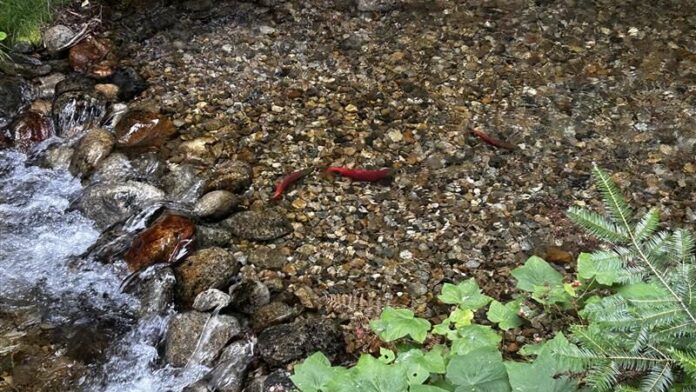The kokanee salmon have begun their migration back to Kokanee Creek, turning the water bright red as their annual spawning run begins.
Kokanee Creek Nature Centre head naturalist Joanne Siderius said the first salmon arrived Aug. 13.
Joanne Siderius, Kokanee Creek Nature Centre, Kokanee Salmon, Nelson, Kokanee Creek
“There were eight at the beginning and as of the 15th, I think there’s 46 of them in there,” she said.
She explained that these salmon are a unique landlocked form of sockeye. Unlike their saltwater cousins, kokanee salmon spend their entire lives in fresh water.
“Twelve thousand years ago, Bonnington Falls blocked what’s now the west arm of the Columbia River out to the ocean. So they spend all of their lives in Kootenay Lake,” she said.
At about three years old, kokanee return to the spawning channels. By then they have stopped eating and their bodies shift to a striking red that colours the creek.
“Once they’ve stopped eating and absorbed their scales and they’re a brilliant red, the females choose a nesting spot in the spawning channel and after she lays eggs, the male fertilizes them,” Siderius said.
After about 10 to 14 days, the fish die, and their bodies provide nutrients for the next generation.
Kokanee salmon are considered a keystone species, meaning they play a critical role in maintaining the local ecosystem.
“That’s why they’re called the keystone species; everything relies on them. If we didn’t have the salmon, it would be like somebody’s garden without fertilizer,” she said.
Best time to visit
For those eager to witness the migration, Siderius recommends visiting at the end of August through the first two weeks of September, when the numbers are at their peak.
“Sometimes there’s one or two kicking around even at Thanksgiving, believe it or not. But basically, the last two weeks in August and the first two weeks in September, that’s when the numbers are the most,” she said.
Rules for visitors
To ensure the safety and preservation of the salmon and the wildlife that depend on them — specifically black bears — Siderius asks visitors to obey some important guidelines:
-
Stay behind fencing and respect barriers along the spawning channels.
-
Dogs are not allowed, as bears can perceive them as a threat.
-
Biking and running are prohibited to avoid disturbing wildlife.
-
No flash photography, as it can disorient animals and startle bears.
“Basically, it’s a matter of respect. Give everybody the opportunity to see the salmon and respect the wildlife while you’re here,” she said.
She also asks visitors to obey signage posted around the spawning channels and to be mindful of local wildlife such as black bears, which feed on the salmon as they prepare for winter denning.
A celebration of resilience
Despite the threat of climate change and habitat loss, the kokanee salmon continue to return year after year — which Siderius said is a testament to both their resilience and ongoing conservation efforts.
“We’re so lucky to still have the kokanee salmon here because they’ve been here for thousands of years and they have made some of our culture the way it is and our ecosystem,”she said.
“They’re declining and we need to respect all the efforts by fisheries and other organizations to make sure that the salmon can still survive in the lake and come back every fall.”
Want to get your business noticed? Have you considered advertising through your local radio station? Speak to one of our sales agents and find out how radio advertising can boost your business today. Call 250-365-7600 or email Vista Radio.





